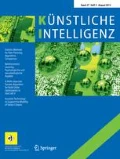Abstract
This paper reports on the aims, the approach, and the results of the European project RACE. The project aim was to enhance the behavior of an autonomous robot by having the robot learn from conceptualized experiences of previous performance, based on initial models of the domain and its own actions in it. This paper introduces the general system architecture; it then sketches some results in detail regarding hybrid reasoning and planning used in RACE, and instances of learning from the experiences of real robot task execution. Enhancement of robot competence is operationalized in terms of performance quality and description length of the robot instructions, and such enhancement is shown to result from the RACE system.






Similar content being viewed by others
References
Baader F, Sertkaya B, Turhan A-Y (2007) Computing the least common subsumer wrt a background terminology. J Appl Logic 5(3):392–420
Bohlken W, Koopmann P, Hotz L, Neumann B (2013) Towards ontology-based realtime behaviour interpretation. In: Guesgen HW, Marsland S (eds) Human behavior recognition technologies: intelligent applications for monitoring and security, IGI Global, pp 33–64
Dubba KSR, Cohn AG, Hogg DC, Bhatt M, Dylla F (2014) Learning relational event models from video, submitted for publication
Dubba KSR, de Oliveira MR, Lim GH, Kasaei H, Seabra Lopes L, Tomé AM, Cohn AG (2014) Grounding language in perception for scene conceptualization in autonomous robots. In: Proceedings of AAAI 2014 spring symposium on qualitative representations for robots
Erol K, Hendler J, Nau DS (1994) HTN planning: complexity and expressivity. In: Proceedings of AAAI
Gentner D (1983) Structure-mapping: a theoretical framework for analogy. Cognit Sci 7(2):155–170
Kasaei SH, Oliveira M, Lim GH, Seabra Lopes L, Tomé AM (2014) An interactive open-ended learning approach for 3d object recognition. In: Proceedings of ICARSC
Konecnỳ Š, Stock S, Pecora F, Saffiotti A (2014) Planning domain+ execution semantics: a way towards robust execution? In: Proceedings of AAAI 2014 spring symposium on qualitative representations for robots
Lehmann J, Neumann B, Bohlken W, Hotz L (2014) A robot waiter that predicts events by high-level scene interpretation. In: Proceedings of 6th international conference agents and artificial intelligence
Lim GH, Oliveira M, Mokhtari V, Kasaei SH, Seabra Lopes L, Tomé MA (2014) Interactive teaching and experience extraction for learning about objects and robot activities. In: Proceedings of RO-MAN (accepted)
Mansouri M, Pecora F (2014) More knowledge on the table: planning with space, time and resources for robots. In: Proceedings of ICRA
Mokhtari V, Lim GH, Seabra Lopes L, Pinho AJ (2014) Gathering and conceptualizing plan-based robot activity experiences. In: Proceedings of IAS
Nau D, Muñoz-Avila H, Cao Y, Lotem A, Mitchell S (2001) Total-order planning with partially ordered subtasks. In: Proceedings of IJCAI
Neumann B, Hotz L, Rost P, Lehmann J (2014) A robot waiter learning from experiences. In: Proceedings of MLDM
Newman MEJ (2003) Ego-centered networks and the ripple effect. Soc Netw 25(1):83–95
Oliveira M, Lim GH, Seabra Lopes L, Kasaei SH, Tomé AM, Chauhan A (2014) A perceptual memory system for grounding semantic representations in intelligent service robots. In: Proceedings of IROS, (accepted)
Quigley M, Conley K, Gerkey BP, Faust J, Foote T, Leibs J, Wheeler R, Ng AY (2009) ROS: an open-source robot operating system. In: Proceedings of ICRA workshop on open source software
RACE: robustness by autonomous competence enhancement. http://race.informatik.uni-hamburg.de/
Rissanen J (1978) Modeling by shortest data description. Automatica 14(5):465–471
Rockel S et al (2013) An ontology-based multi-level robot architecture for learning from experiences. In: Proceedings of designing intelligent robots, reintegrating AI II, AAAI spring symposium,
Rockel S, Klimentjew D, Zhang L, Zhang J (2014) An hyperreality imagination based reasoning and evaluation system (HIRES). In: Proceedings of ICRA
Tayyub J, Tavanai A, Gatsoulis Y, Cohn AG, Hogg D (2014) Qualitative and quantitative spatio-temporal relations in daily living activity recognition. University of Leeds, technical report
Acknowledgments
RACE is funded by the EC FP7-ICT-2011-7, Grant no. 287752, which is greatly appreciated. Comments by the anonymous reviewers have helped improve this paper.
Author information
Authors and Affiliations
Corresponding author
Rights and permissions
About this article
Cite this article
Hertzberg, J., Zhang, J., Zhang, L. et al. The RACE Project. Künstl Intell 28, 297–304 (2014). https://doi.org/10.1007/s13218-014-0327-y
Published:
Issue Date:
DOI: https://doi.org/10.1007/s13218-014-0327-y




